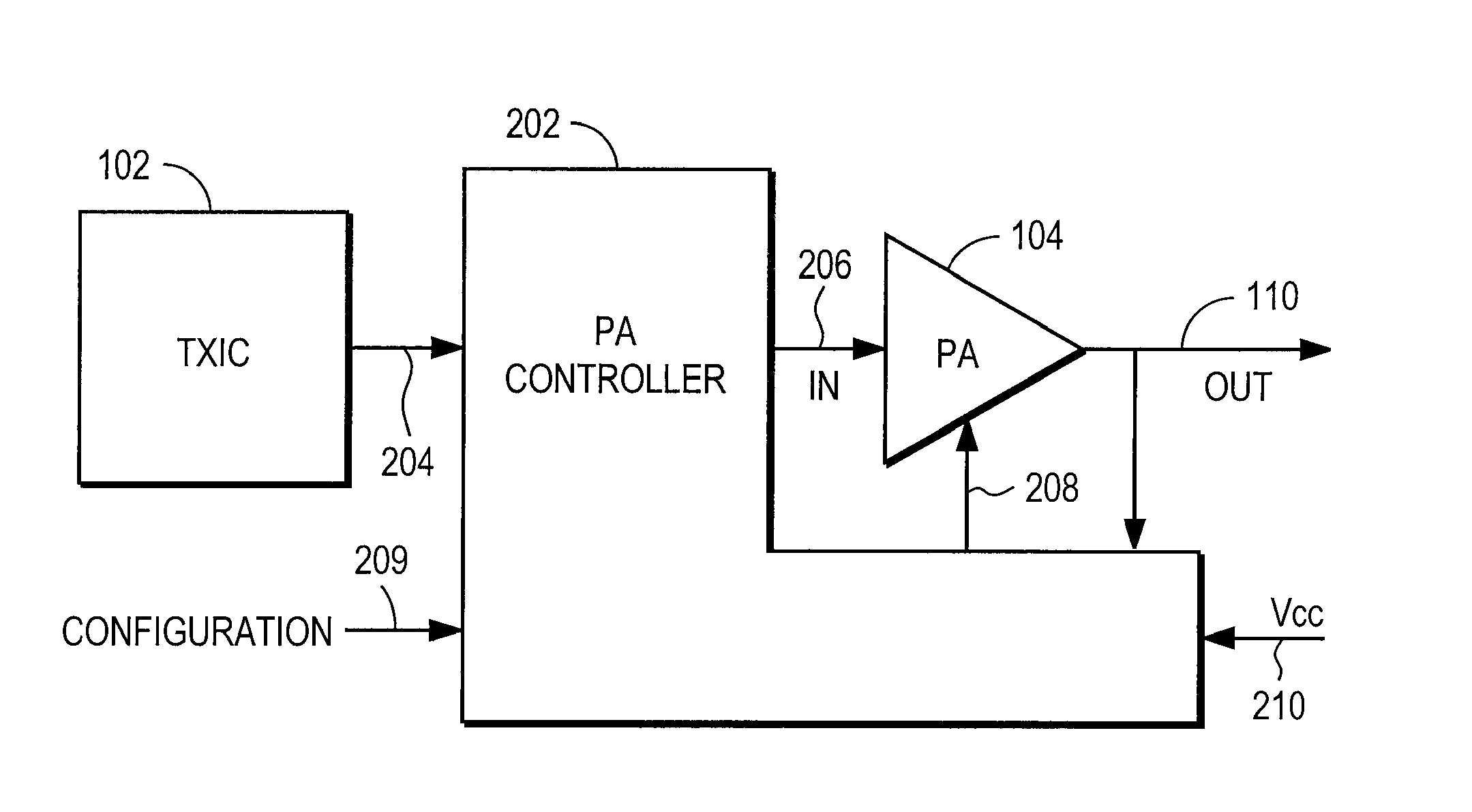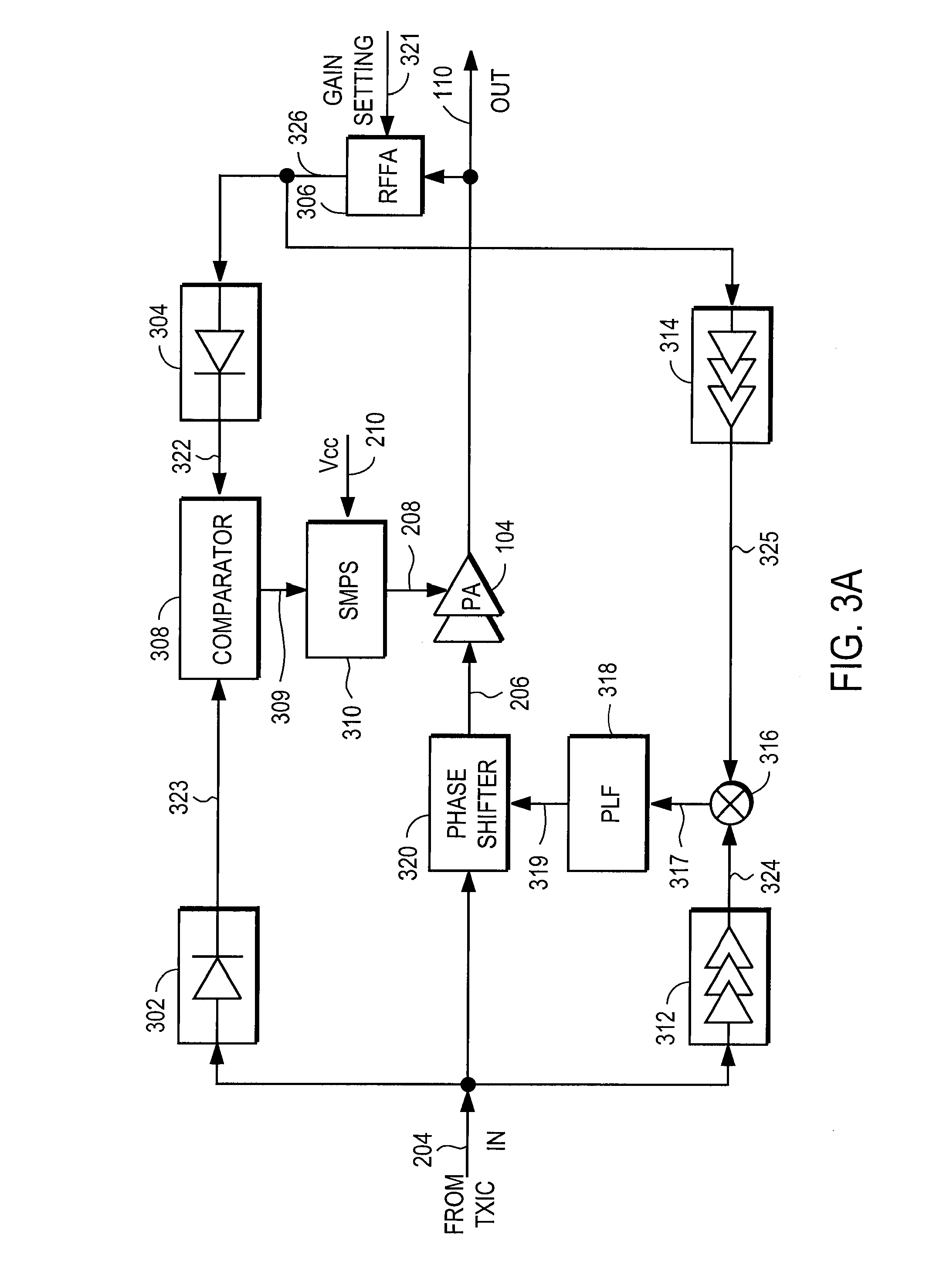RF Power Amplifier Controller Circuit Including Calibrated Phase Control Loop
a controller circuit and phase control technology, applied in the direction of rf amplifiers, transmissions, gain control, etc., can solve the problems of sacrificing more efficiency, /b>waste of power during the peak of amplitude, undesirable wide spectral occupancy, etc., to achieve narrow bandwidth, reduce amplitude, and achieve the effect of reducing amplitude and reducing amplitud
- Summary
- Abstract
- Description
- Claims
- Application Information
AI Technical Summary
Benefits of technology
Problems solved by technology
Method used
Image
Examples
first embodiment
[0049]FIG. 3A illustrates an RF PA system, according to the present invention. The RF PA system includes the PA 104, and the PA controller 202 including a closed amplitude control loop and a closed phase control loop.
[0050] The phase control loop includes two limiters 312, 314, a phase comparator 316, a loop filter (PLF (Phase Loop Filter)) 318, and a phase shifter 320. To achieve stability over all conditions, the phase comparator 316 is of an adequate type with a capture range greater than 2*PI. To achieve this, a combination of adjustable delay elements and frequency dividers may be used. Also a phase sub-ranging system can be used since the dynamic phase variations that the phase correction loop processes are limited in amplitude. A sub-ranging phase control block (not shown) could be one of the constituents of the phase comparator 316 used with this system. Advantages of using sub-ranging in the phase comparator 316 are stability and good noise.
[0051] The amplitude control loo...
second embodiment
[0062]FIG. 4A illustrates an RF PA system, according to the present invention. The RF PA system illustrated in FIG. 4A is substantially the same as the RF transmitter circuit illustrated in FIG. 3A, except that (i) the amplitude correction signal 309 is split into two signals, a high frequency amplitude correction signal 401 that is fed into a high frequency path including a linear regulator 402 and a low frequency amplitude correction signal 403 that is fed into a low frequency path including an SMPS 404 and that (ii) the outputs of the linear regulator 402 and the SMPS 404 are combined in the adder block 406 to generate the adjusted supply voltage 208 to the PA 104. For example, a simple current adding node, a small, high frequency transformer or other types of active electronic solutions can be used as the adder block 406. Any other types of power combiner circuits may be used as the adder block 406. The high frequency amplitude correction signal 401 is input to the linear regula...
third embodiment
[0075] In the embodiment of FIG. 5A, the independent programming of gain and compression point by the closed amplitude control loop also makes it possible to reduce the amount of high frequency energy that the power supply system (linear regulator) has to deliver to the PA 104. This can be done by having the variable gain amplifier 502 correct for some of the gain error at a higher speed than the Vcc control loop (closed on node 208) can do, thus reducing the amount of correction that is to be done by the low efficiency, high frequency branch (linear regulator 401). Thus, the bandwidth of the signals at nodes 208 and 504 can be made to be significantly different. Since only a small fraction of the energy resides at high frequencies, there is only a small penalty in efficiency for reducing the bandwidth of the control at node 208 relative to the bandwidth at node 504. The ratio of the two active bandwidths is part of the design trade-off for the whole system. The gain control block 5...
PUM
 Login to View More
Login to View More Abstract
Description
Claims
Application Information
 Login to View More
Login to View More - R&D
- Intellectual Property
- Life Sciences
- Materials
- Tech Scout
- Unparalleled Data Quality
- Higher Quality Content
- 60% Fewer Hallucinations
Browse by: Latest US Patents, China's latest patents, Technical Efficacy Thesaurus, Application Domain, Technology Topic, Popular Technical Reports.
© 2025 PatSnap. All rights reserved.Legal|Privacy policy|Modern Slavery Act Transparency Statement|Sitemap|About US| Contact US: help@patsnap.com



